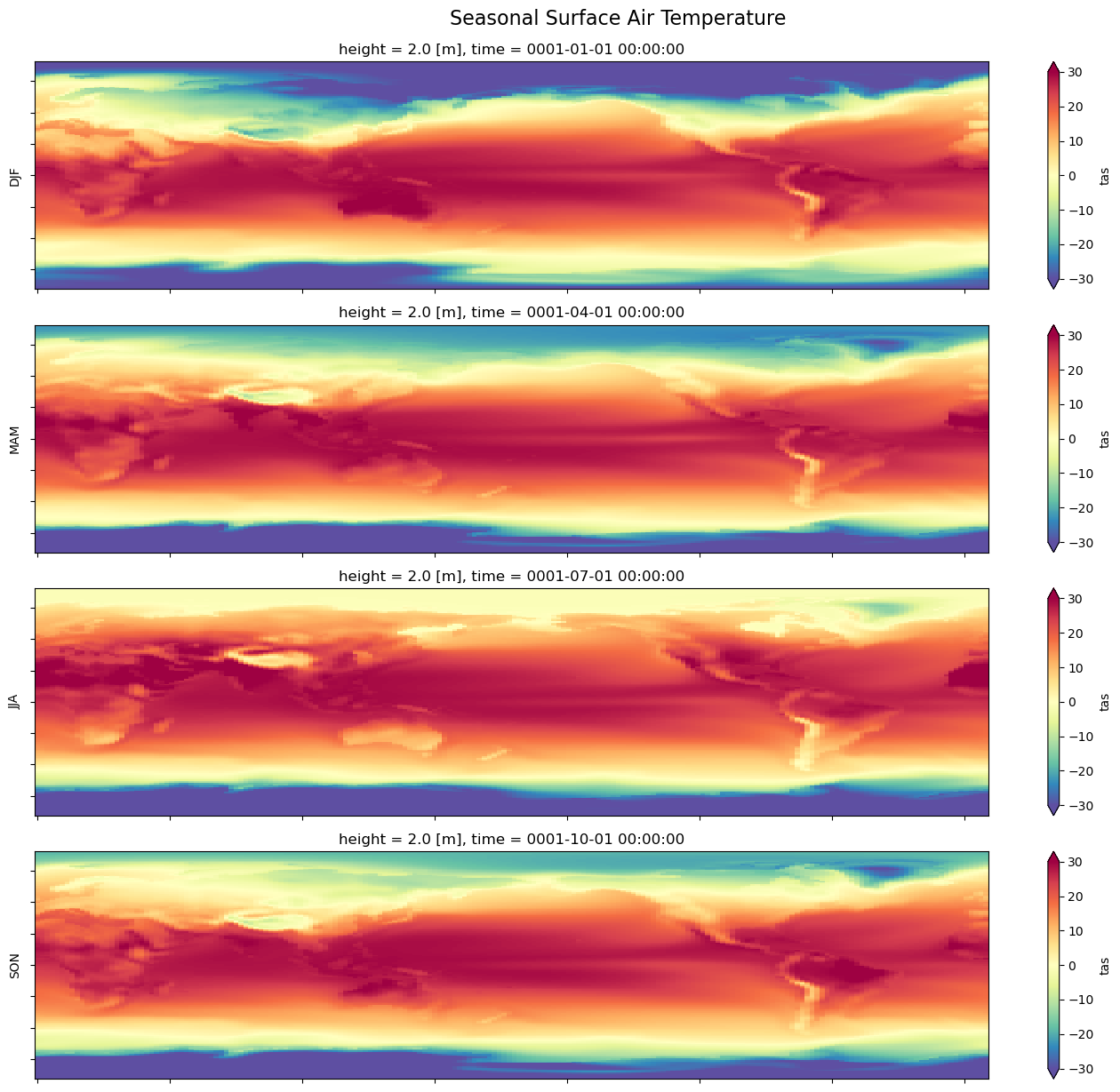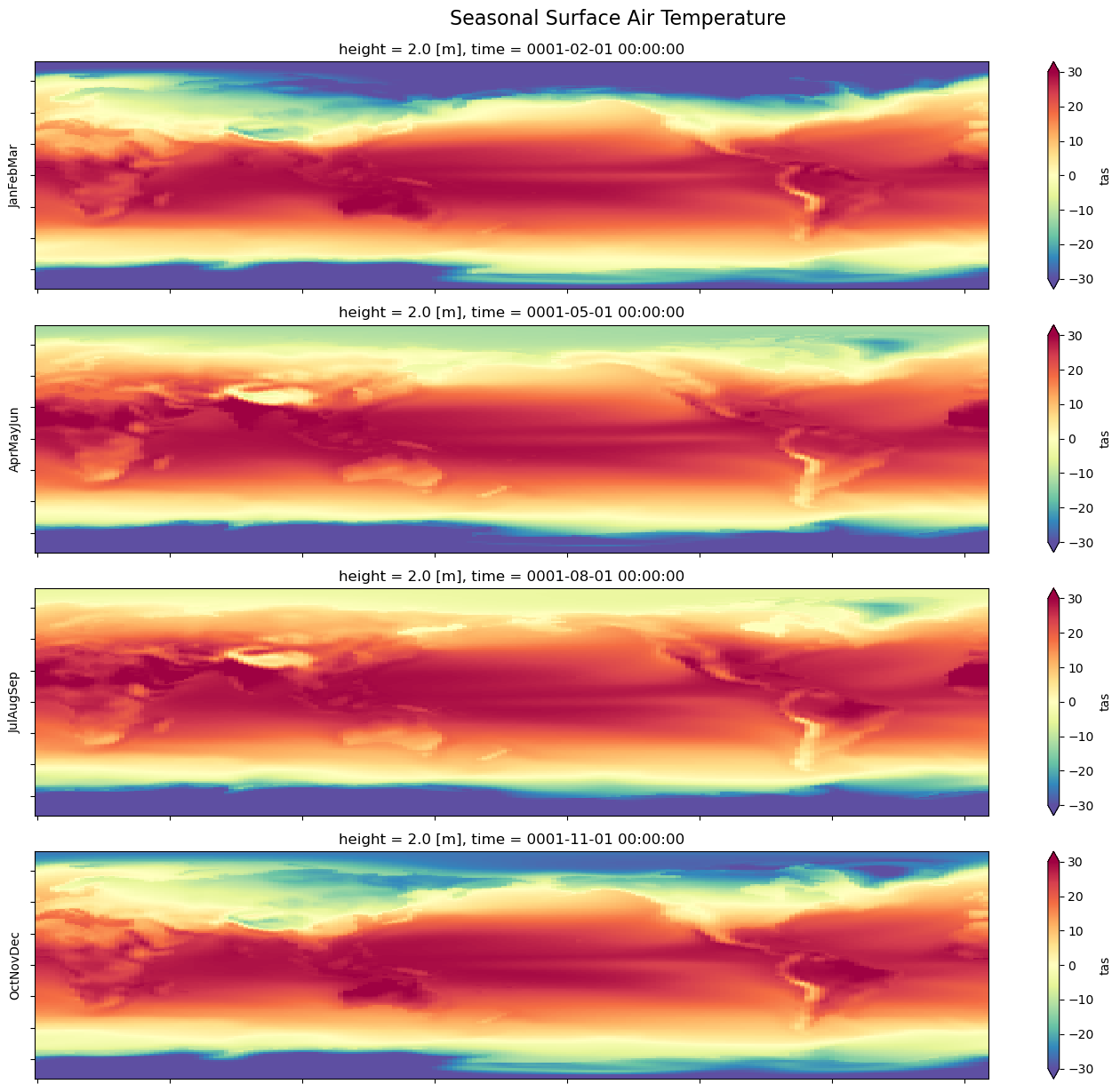Calculating Climatology and Departures from Time Series Data#
Author: Tom Vo
Date: 05/27/22
Last Updated: 2/27/23
Related APIs:
The data used in this example can be found through the Earth System Grid Federation (ESGF) search portal.
Overview#
Suppose we have two netCDF4 files for air temperature data (tas).
File 1: Monthly frequency from 1850-01-16 to 2014-12-16
We want to calculate the annual and seasonal cycle climatologies and departures using this file.
File 2: Hourly frequency from 2010-01-01 to 2015-01-01 (subset).
We want to calculate the daily cycle climatologies and departures using this file.
Notebook Setup#
Create an Anaconda environment for this notebook using the command below, then select the kernel in Jupyter.
conda create -n xcdat_notebook -c conda-forge python xarray netcdf4 xcdat xesmf matplotlib nc-time-axis jupyter
xesmfis required for horizontal regridding with xESMFmatplotlibis an optional dependency required for plotting with xarraync-time-axisis an optional dependency required formatplotlibto plotcftimecoordinates
[1]:
%matplotlib inline
import matplotlib.pyplot as plt
import pandas as pd
import xcdat
1. Open Sample Datasets#
We are using xarray’s OPeNDAP support to read a netCDF4 dataset files directly from their source. The data is not loaded over the network until we perform operations on it (e.g., temperature unit adjustment).
More information on the xarray’s OPeNDAP support can be found here.
File 1: Monthly Frequency#
[2]:
filepath1 = "http://esgf.nci.org.au/thredds/dodsC/master/CMIP6/CMIP/CSIRO/ACCESS-ESM1-5/historical/r10i1p1f1/Amon/tas/gn/v20200605/tas_Amon_ACCESS-ESM1-5_historical_r10i1p1f1_gn_185001-201412.nc"
ds_monthly = xcdat.open_dataset(filepath1)
# Unit adjust (-273.15, K to C)
ds_monthly["tas"] = ds_monthly.tas - 273.15
ds_monthly
[2]:
<xarray.Dataset> Size: 221MB
Dimensions: (time: 1980, bnds: 2, lat: 145, lon: 192)
Coordinates:
* lat (lat) float64 1kB -90.0 -88.75 -87.5 -86.25 ... 87.5 88.75 90.0
* lon (lon) float64 2kB 0.0 1.875 3.75 5.625 ... 354.4 356.2 358.1
height float64 8B 2.0
* time (time) object 16kB 1850-01-16 12:00:00 ... 2014-12-16 12:00:00
Dimensions without coordinates: bnds
Data variables:
time_bnds (time, bnds) object 32kB ...
lat_bnds (lat, bnds) float64 2kB ...
lon_bnds (lon, bnds) float64 3kB ...
tas (time, lat, lon) float32 220MB -27.19 -27.19 ... -25.29 -25.29
Attributes: (12/48)
Conventions: CF-1.7 CMIP-6.2
activity_id: CMIP
branch_method: standard
branch_time_in_child: 0.0
branch_time_in_parent: 87658.0
creation_date: 2020-06-05T04:06:11Z
... ...
variant_label: r10i1p1f1
version: v20200605
license: CMIP6 model data produced by CSIRO is li...
cmor_version: 3.4.0
tracking_id: hdl:21.14100/af78ae5e-f3a6-4e99-8cfe-5f2...
DODS_EXTRA.Unlimited_Dimension: timeFile 2: Hourly Frequency#
The size of this file is approximately 1.17 GB, so we will be chunking our request using Dask to avoid hitting the OPeNDAP file size request limit for this ESGF node.
[3]:
filepath2 = "http://esgf.nci.org.au/thredds/dodsC/master/CMIP6/CMIP/CSIRO/ACCESS-ESM1-5/historical/r10i1p1f1/3hr/tas/gn/v20200605/tas_3hr_ACCESS-ESM1-5_historical_r10i1p1f1_gn_201001010300-201501010000.nc"
ds_hourly = xcdat.open_dataset(filepath2, chunks={"time": "auto"}, add_bounds=["T"])
# Unit adjust (-273.15, K to C)
ds_hourly["tas"] = ds_hourly.tas - 273.15
ds_hourly
[3]:
<xarray.Dataset> Size: 2GB
Dimensions: (lat: 145, bnds: 2, lon: 192, time: 14608)
Coordinates:
* lat (lat) float64 1kB -90.0 -88.75 -87.5 -86.25 ... 87.5 88.75 90.0
* lon (lon) float64 2kB 0.0 1.875 3.75 5.625 ... 354.4 356.2 358.1
height float64 8B ...
* time (time) object 117kB 2010-01-01 03:00:00 ... 2015-01-01 00:00:00
Dimensions without coordinates: bnds
Data variables:
lat_bnds (lat, bnds) float64 2kB dask.array<chunksize=(145, 2), meta=np.ndarray>
lon_bnds (lon, bnds) float64 3kB dask.array<chunksize=(192, 2), meta=np.ndarray>
tas (time, lat, lon) float32 2GB dask.array<chunksize=(1205, 145, 192), meta=np.ndarray>
time_bnds (time, bnds) object 234kB 2010-01-01 03:00:00 ... 2015-01-01 0...
Attributes: (12/48)
Conventions: CF-1.7 CMIP-6.2
activity_id: CMIP
branch_method: standard
branch_time_in_child: 0.0
branch_time_in_parent: 87658.0
creation_date: 2020-06-05T04:54:56Z
... ...
variant_label: r10i1p1f1
version: v20200605
license: CMIP6 model data produced by CSIRO is li...
cmor_version: 3.4.0
tracking_id: hdl:21.14100/b79e6a05-c482-46cf-b3b8-83b...
DODS_EXTRA.Unlimited_Dimension: time2. Calculate Climatology#
Related API: xarray.Dataset.temporal.climatology()
In this example, we will be calculating the weighted climatology of the tas variable for its seasonal, annual, and daily cycles.
Helpful knowledge:
Masked (missing) data is automatically handled.
The weight of masked (missing) data is excluded when averages are calculated. This is the same as giving them a weight of 0.
If desired, use the
reference_periodargument to calculate a climatology based on a climatological reference period (a subset of the entire time series). If no value is provided, the climatological reference period will be the full period covered by the dataset.
Seasonal Climatology#
Groups time coordinates by season
The season_config dictionary keyword argument can be passed to .climatology() for more granular configuration. We will be sticking with the default settings.
[4]:
season_climo = ds_monthly.temporal.climatology(
"tas",
freq="season",
weighted=True,
season_config={"dec_mode": "DJF", "drop_incomplete_djf": True},
)
[5]:
season_climo.tas
[5]:
<xarray.DataArray 'tas' (time: 4, lat: 145, lon: 192)> Size: 891kB
array([[[-31.00774765, -31.00774765, -31.00774765, ..., -31.00774765,
-31.00774765, -31.00774765],
[-29.65324402, -29.685215 , -29.71771049, ..., -29.55809784,
-29.58923149, -29.62030983],
[-28.88215446, -28.98016167, -29.07778549, ..., -28.58658791,
-28.68405914, -28.78241539],
...,
[-31.36740303, -31.31291962, -31.25907516, ..., -31.54325676,
-31.47868538, -31.42434502],
[-31.88631248, -31.86421967, -31.84326553, ..., -31.95551682,
-31.93475533, -31.91006279],
[-32.83132172, -32.83132172, -32.83132172, ..., -32.83132172,
-32.83132172, -32.83132172]],
[[-53.70133972, -53.70133972, -53.70133972, ..., -53.70133972,
-53.70133972, -53.70133972],
[-50.02594376, -50.07233047, -50.11901093, ..., -49.88347626,
-49.93112564, -49.97804642],
[-49.16661835, -49.29807281, -49.42589951, ..., -48.75580978,
-48.89396286, -49.03115463],
...
[ -1.05963409, -1.05649328, -1.05370045, ..., -1.06824732,
-1.06510675, -1.06242192],
[ -1.06418574, -1.06315029, -1.06234932, ..., -1.06742334,
-1.06604695, -1.06509995],
[ -1.12615526, -1.12615526, -1.12615526, ..., -1.12615526,
-1.12615526, -1.12615526]],
[[-48.71931076, -48.71931076, -48.71931076, ..., -48.71931076,
-48.71931076, -48.71931076],
[-45.70309448, -45.74006271, -45.77688599, ..., -45.59179306,
-45.62841034, -45.664814 ],
[-44.89496231, -44.9999733 , -45.10230255, ..., -44.5642662 ,
-44.67589569, -44.78623962],
...,
[-18.21715736, -18.16695976, -18.11590195, ..., -18.38574219,
-18.32255554, -18.27195358],
[-18.61506462, -18.59276581, -18.57180786, ..., -18.68408012,
-18.66509819, -18.64017296],
[-19.34391594, -19.34391594, -19.34391594, ..., -19.34391594,
-19.34391594, -19.34391594]]])
Coordinates:
* lat (lat) float64 1kB -90.0 -88.75 -87.5 -86.25 ... 87.5 88.75 90.0
* lon (lon) float64 2kB 0.0 1.875 3.75 5.625 ... 352.5 354.4 356.2 358.1
height float64 8B 2.0
* time (time) object 32B 0001-01-01 00:00:00 ... 0001-10-01 00:00:00
Attributes:
operation: temporal_avg
mode: climatology
freq: season
weighted: True
dec_mode: DJF
drop_incomplete_djf: True[6]:
notnull = pd.notnull(season_climo["tas"][0])
tas_season = season_climo.tas
fig, axes = plt.subplots(nrows=4, ncols=1, figsize=(14, 12))
for i, season in enumerate(("DJF", "MAM", "JJA", "SON")):
tas_season.isel(time=i).where(notnull).plot.pcolormesh(
ax=axes[i],
vmin=-30,
vmax=30,
cmap="Spectral_r",
add_colorbar=True,
extend="both",
)
axes[i].set_ylabel(season)
for ax in axes.flat:
ax.axes.get_xaxis().set_ticklabels([])
ax.axes.get_yaxis().set_ticklabels([])
ax.axes.axis("tight")
ax.set_xlabel("")
plt.tight_layout()
fig.suptitle("Seasonal Surface Air Temperature", fontsize=16, y=1.02)
[6]:
Text(0.5, 1.02, 'Seasonal Surface Air Temperature')

Notice that the time coordinates are cftime objects, with each season (“DJF”, “MAM”, “JJA”, and “SON”) represented by its middle month.
cftime objects are used because the time coordiantes are outside the Timestamp-valid range (approximately between years 1678 and 2262).
More info here: https://xarray.pydata.org/en/v2022.03.0/user-guide/weather-climate.html#non-standard-calendars-and-dates-outside-the-timestamp-valid-range
[7]:
season_climo.time
[7]:
<xarray.DataArray 'time' (time: 4)> Size: 32B
array([cftime.DatetimeProlepticGregorian(1, 1, 1, 0, 0, 0, 0, has_year_zero=True),
cftime.DatetimeProlepticGregorian(1, 4, 1, 0, 0, 0, 0, has_year_zero=True),
cftime.DatetimeProlepticGregorian(1, 7, 1, 0, 0, 0, 0, has_year_zero=True),
cftime.DatetimeProlepticGregorian(1, 10, 1, 0, 0, 0, 0, has_year_zero=True)],
dtype=object)
Coordinates:
height float64 8B 2.0
* time (time) object 32B 0001-01-01 00:00:00 ... 0001-10-01 00:00:00
Attributes:
bounds: time_bnds
axis: T
long_name: time
standard_name: time
_ChunkSizes: 1Custom Seasonal Climatology#
Groups time coordinates by season
To calculate custom seasonal cycle climatology, we must first define our custom seasons using the season_config dictionary and the "custom_seasons" key.
"custom_seasons" must be a list of sublists containing month strings, with each sublist representing a custom season.
Month strings must be in the three letter format (e.g., ‘Jan’)
Each month must be included once in a custom season
Order of the months in each custom season does not matter
Custom seasons can vary in length
[8]:
custom_seasons = [
["Jan", "Feb", "Mar"], # "JanFebMar"
["Apr", "May", "Jun"], # "AprMayJun"
["Jul", "Aug", "Sep"], # "JunJulAug"
["Oct", "Nov", "Dec"], # "OctNovDec"
]
c_season_climo = ds_monthly.temporal.climatology(
"tas",
freq="season",
weighted=True,
season_config={"custom_seasons": custom_seasons},
)
[9]:
c_season_climo.tas
[9]:
<xarray.DataArray 'tas' (time: 4, lat: 145, lon: 192)> Size: 891kB
array([[[-38.74568939, -38.74568939, -38.74568939, ..., -38.74568939,
-38.74568939, -38.74568939],
[-36.58245468, -36.61849976, -36.65530777, ..., -36.47352982,
-36.50952148, -36.54521942],
[-35.74017334, -35.84892654, -35.95645142, ..., -35.40914154,
-35.51865387, -35.62909698],
...,
[-32.0694809 , -32.01528931, -31.96115875, ..., -32.24432373,
-32.18037796, -32.1263504 ],
[-32.59425354, -32.57166672, -32.55008316, ..., -32.66543961,
-32.64432526, -32.61899185],
[-33.51273727, -33.51273727, -33.51273727, ..., -33.51273727,
-33.51273727, -33.51273727]],
[[-56.2096405 , -56.2096405 , -56.2096405 , ..., -56.2096405 ,
-56.2096405 , -56.2096405 ],
[-52.31330872, -52.36031723, -52.40692902, ..., -52.16948318,
-52.21759415, -52.26473999],
[-51.48299408, -51.61407852, -51.74102783, ..., -51.06825256,
-51.20875549, -51.34703445],
...
[ -4.15014648, -4.13455486, -4.11836147, ..., -4.20478487,
-4.18330002, -4.16762114],
[ -4.25911999, -4.25162458, -4.24448299, ..., -4.28251314,
-4.2763319 , -4.26777029],
[ -4.44926548, -4.44926548, -4.44926548, ..., -4.44926548,
-4.44926548, -4.44926548]],
[[-38.29449081, -38.29449081, -38.29449081, ..., -38.29449081,
-38.29449081, -38.29449081],
[-36.35746002, -36.39224243, -36.42734528, ..., -36.25349045,
-36.28746796, -36.32162476],
[-35.58590698, -35.68638992, -35.78586197, ..., -35.27788162,
-35.38057709, -35.48319244],
...,
[-24.59911537, -24.54461861, -24.49049377, ..., -24.7778244 ,
-24.71206665, -24.65720177],
[-25.07014275, -25.04795647, -25.027174 , ..., -25.13942909,
-25.1194191 , -25.09457588],
[-25.95426178, -25.95426178, -25.95426178, ..., -25.95426178,
-25.95426178, -25.95426178]]])
Coordinates:
* lat (lat) float64 1kB -90.0 -88.75 -87.5 -86.25 ... 87.5 88.75 90.0
* lon (lon) float64 2kB 0.0 1.875 3.75 5.625 ... 352.5 354.4 356.2 358.1
height float64 8B 2.0
* time (time) object 32B 0001-02-01 00:00:00 ... 0001-11-01 00:00:00
Attributes:
operation: temporal_avg
mode: climatology
freq: season
weighted: True
custom_seasons: ['JanFebMar', 'AprMayJun', 'JulAugSep', 'OctNovDec'][10]:
notnull = pd.notnull(c_season_climo["tas"][0])
tas_c_season = c_season_climo.tas
fig, axes = plt.subplots(nrows=4, ncols=1, figsize=(14, 12))
for i, season in enumerate(tas_c_season.attrs["custom_seasons"]):
tas_c_season.isel(time=i).where(notnull).plot.pcolormesh(
ax=axes[i],
vmin=-30,
vmax=30,
cmap="Spectral_r",
add_colorbar=True,
extend="both",
)
axes[i].set_ylabel(season)
for ax in axes.flat:
ax.axes.get_xaxis().set_ticklabels([])
ax.axes.get_yaxis().set_ticklabels([])
ax.axes.axis("tight")
ax.set_xlabel("")
plt.tight_layout()
fig.suptitle("Seasonal Surface Air Temperature", fontsize=16, y=1.02)
[10]:
Text(0.5, 1.02, 'Seasonal Surface Air Temperature')

Annual Climatology#
Groups time coordinates by month
[11]:
annual_climo = ds_monthly.temporal.climatology("tas", freq="month", weighted=True)
[12]:
annual_climo.tas
[12]:
<xarray.DataArray 'tas' (time: 12, lat: 145, lon: 192)> Size: 3MB
array([[[-28.21442795, -28.21442795, -28.21442795, ..., -28.21442795,
-28.21442795, -28.21442795],
[-27.14847946, -27.17834282, -27.20867348, ..., -27.06005478,
-27.08879089, -27.11763954],
[-26.4435463 , -26.53694916, -26.62967873, ..., -26.1612587 ,
-26.25445938, -26.34812355],
...,
[-31.93053436, -31.87295341, -31.81675529, ..., -32.11352158,
-32.04728317, -31.99032974],
[-32.46694946, -32.44190598, -32.41777802, ..., -32.543293 ,
-32.52000809, -32.4929657 ],
[-33.39895248, -33.39895248, -33.39895248, ..., -33.39895248,
-33.39895248, -33.39895248]],
[[-37.97247314, -37.97247314, -37.97247314, ..., -37.97247314,
-37.97247314, -37.97247314],
[-35.9917984 , -36.02771759, -36.06422424, ..., -35.88243866,
-35.91858673, -35.9542923 ],
[-35.13148499, -35.23939133, -35.34668732, ..., -34.80545044,
-34.91286087, -35.02162933],
...
[-24.97770691, -24.91987419, -24.86286926, ..., -25.1666317 ,
-25.09855843, -25.03938293],
[-25.40159607, -25.37743568, -25.3551445 , ..., -25.47573471,
-25.45422173, -25.42788887],
[-26.30274582, -26.30274582, -26.30274582, ..., -26.30274582,
-26.30274582, -26.30274582]],
[[-27.46326065, -27.46326065, -27.46326065, ..., -27.46326065,
-27.46326065, -27.46326065],
[-26.38991165, -26.42050743, -26.45174217, ..., -26.30039787,
-26.32954788, -26.35881042],
[-25.6327858 , -25.72666359, -25.82057571, ..., -25.35087395,
-25.44388771, -25.53768921],
...,
[-29.80114746, -29.74719429, -29.69542122, ..., -29.973629 ,
-29.90939331, -29.85676384],
[-30.31214523, -30.29234123, -30.27323341, ..., -30.3752346 ,
-30.35642242, -30.3335495 ],
[-31.22587013, -31.22587013, -31.22587013, ..., -31.22587013,
-31.22587013, -31.22587013]]])
Coordinates:
* lat (lat) float64 1kB -90.0 -88.75 -87.5 -86.25 ... 87.5 88.75 90.0
* lon (lon) float64 2kB 0.0 1.875 3.75 5.625 ... 352.5 354.4 356.2 358.1
height float64 8B 2.0
* time (time) object 96B 0001-01-01 00:00:00 ... 0001-12-01 00:00:00
Attributes:
operation: temporal_avg
mode: climatology
freq: month
weighted: TrueDaily Climatology#
Groups time coordinates by month and day.
Leap days (if present) are dropped if the CF calendar type is "gregorian", "proleptic_gregorian", or "standard".
[13]:
daily_climo = ds_hourly.temporal.climatology("tas", freq="day", weighted=True)
[14]:
daily_climo.tas
[14]:
<xarray.DataArray 'tas' (time: 365, lat: 145, lon: 192)> Size: 81MB
dask.array<truediv, shape=(365, 145, 192), dtype=float64, chunksize=(1, 145, 192), chunktype=numpy.ndarray>
Coordinates:
* lat (lat) float64 1kB -90.0 -88.75 -87.5 -86.25 ... 87.5 88.75 90.0
* lon (lon) float64 2kB 0.0 1.875 3.75 5.625 ... 352.5 354.4 356.2 358.1
height float64 8B ...
* time (time) object 3kB 0001-01-01 00:00:00 ... 0001-12-31 00:00:00
Attributes:
operation: temporal_avg
mode: climatology
freq: day
weighted: True3. Calculate Departures (Anomalies)#
Related API: xarray.Dataset.temporal.departures()
In this example, we will be calculating the weighted departures of the tas variable for its seasonal, annual, and daily cycles.
Helpful knowledge:
What are anomalies?
In climatology, “anomalies” refer to the difference between the value during a given time interval (e.g., the January average surface air temperature) and the long-term average value for that time interval (e.g., the average surface temperature over the last 30 Januaries).
How is the climatology calculated?
In the departures API, the reference climatology is calculated internally so there is no need to pass one to this method.
You can still calculate the reference climatology using the climatology API.
If desired, use the
reference_periodargument to calculate anomalies relative to a climatological reference period (a subset of the entire time series). If no value is provided, the climatological reference period will be the full period covered by the dataset.
Masked (missing) data is automatically handled.
The weight of masked (missing) data is excluded when averages are calculated. This is the same as giving them a weight of 0.
Seasonal Anomalies#
The season_config dictionary keyword argument can be passed to .departures() for more granular configuration. We will be sticking with the default settings.
[15]:
season_departures = ds_monthly.temporal.departures(
"tas",
freq="season",
weighted=True,
season_config={"dec_mode": "DJF", "drop_incomplete_djf": True},
)
[16]:
season_departures.tas
[16]:
<xarray.DataArray 'tas' (time: 659, lat: 145, lon: 192)> Size: 147MB
array([[[-0.58952332, -0.58952332, -0.58952332, ..., -0.58952332,
-0.58952332, -0.58952332],
[-1.09177017, -1.10290527, -1.11154175, ..., -1.05168915,
-1.06544495, -1.0780983 ],
[-1.15142822, -1.188591 , -1.22366714, ..., -1.03422165,
-1.07611465, -1.11405563],
...,
[-1.49987602, -1.47577286, -1.44530678, ..., -1.55906868,
-1.53568459, -1.51602364],
[-1.70767593, -1.68932533, -1.66731644, ..., -1.76281166,
-1.74707222, -1.72536469],
[-1.46803665, -1.46803665, -1.46803665, ..., -1.46803665,
-1.46803665, -1.46803665]],
[[-1.97722244, -1.97722244, -1.97722244, ..., -1.97722244,
-1.97722244, -1.97722244],
[-1.78523636, -1.78010559, -1.7770462 , ..., -1.78342056,
-1.78052139, -1.78041077],
[-1.86477661, -1.86896515, -1.87456131, ..., -1.84337997,
-1.84798431, -1.85388184],
...
[ 0.50043428, 0.50759256, 0.5102756 , ..., 0.50164866,
0.50169188, 0.50637573],
[ 0.50042224, 0.50507736, 0.50940531, ..., 0.48725533,
0.4880656 , 0.49204886],
[ 0.54013848, 0.54013848, 0.54013848, ..., 0.54013848,
0.54013848, 0.54013848]],
[[ 0.21573257, 0.21573257, 0.21573257, ..., 0.21573257,
0.21573257, 0.21573257],
[ 0.00947952, -0.00642776, -0.0196228 , ..., 0.05247498,
0.037117 , 0.02135849],
[ 0.04763412, 0.01293564, -0.02537918, ..., 0.16802216,
0.13085556, 0.08817673],
...,
[ 5.87438297, 5.94229126, 6.00926971, ..., 5.6408205 ,
5.7134676 , 5.79356194],
[ 5.48866081, 5.5266571 , 5.56793213, ..., 5.37800312,
5.40638351, 5.44045258],
[ 5.05544662, 5.05544662, 5.05544662, ..., 5.05544662,
5.05544662, 5.05544662]]])
Coordinates:
* lat (lat) float64 1kB -90.0 -88.75 -87.5 -86.25 ... 87.5 88.75 90.0
* lon (lon) float64 2kB 0.0 1.875 3.75 5.625 ... 352.5 354.4 356.2 358.1
height float64 8B 2.0
* time (time) object 5kB 1850-04-01 00:00:00 ... 2014-10-01 00:00:00
Attributes:
operation: temporal_avg
mode: departures
freq: season
weighted: True
dec_mode: DJF
drop_incomplete_djf: TrueCustom Seasonal Anomalies#
To calculate custom seasonal cycle anomalies, we must first define our custom seasons using the season_config dictionary and the "custom_seasons" key.
"custom_seasons" must be a list of sublists containing month strings, with each sublist representing a custom season.
Month strings must be in the three letter format (e.g., ‘Jan’)
Each month must be included once in a custom season
Order of the months in each custom season does not matter
Custom seasons can vary in length
[17]:
custom_seasons = [
["Jan", "Feb", "Mar"], # "JanFebMar"
["Apr", "May", "Jun"], # "AprMayJun"
["Jul", "Aug", "Sep"], # "JulAugSep"
["Oct", "Nov", "Dec"], # "OctNovDec"
]
c_season_departs = ds_monthly.temporal.departures(
"tas",
freq="season",
weighted=True,
season_config={"custom_seasons": custom_seasons},
)
[18]:
c_season_departs.tas
[18]:
<xarray.DataArray 'tas' (time: 660, lat: 145, lon: 192)> Size: 147MB
array([[[ 0.30404663, 0.30404663, 0.30404663, ..., 0.30404663,
0.30404663, 0.30404663],
[ 0.36520004, 0.35329437, 0.33778 , ..., 0.40762329,
0.3941803 , 0.38028717],
[ 0.5711937 , 0.54114532, 0.51060486, ..., 0.6612854 ,
0.63129425, 0.6011467 ],
...,
[-4.49204254, -4.49573517, -4.49764633, ..., -4.45085144,
-4.46473312, -4.47567368],
[-4.54133224, -4.54836273, -4.55043411, ..., -4.50736237,
-4.5208168 , -4.53223419],
[-4.10101318, -4.10101318, -4.10101318, ..., -4.10101318,
-4.10101318, -4.10101318]],
[[-2.3446846 , -2.3446846 , -2.3446846 , ..., -2.3446846 ,
-2.3446846 , -2.3446846 ],
[-2.72401428, -2.72953033, -2.73215485, ..., -2.69366455,
-2.70578384, -2.71579742],
[-2.8057785 , -2.83257294, -2.85590363, ..., -2.70781326,
-2.74424744, -2.77590179],
...
[ 1.75831985, 1.75575376, 1.75691819, ..., 1.77385426,
1.76290703, 1.75874662],
[ 1.87204409, 1.87170196, 1.87422705, ..., 1.87372851,
1.87358499, 1.87194395],
[ 2.00157356, 2.00157356, 2.00157356, ..., 2.00157356,
2.00157356, 2.00157356]],
[[-0.28557205, -0.28557205, -0.28557205, ..., -0.28557205,
-0.28557205, -0.28557205],
[-0.26680374, -0.27238464, -0.27745056, ..., -0.25345993,
-0.25799179, -0.26165771],
[-0.24026489, -0.25225067, -0.26608276, ..., -0.19800949,
-0.21153641, -0.22675705],
...,
[ 6.18972588, 6.28137779, 6.36515808, ..., 5.88415146,
5.9856987 , 6.09294701],
[ 5.75325775, 5.79308891, 5.85096931, ..., 5.61413383,
5.64881134, 5.69875908],
[ 5.32911682, 5.32911682, 5.32911682, ..., 5.32911682,
5.32911682, 5.32911682]]])
Coordinates:
* lat (lat) float64 1kB -90.0 -88.75 -87.5 -86.25 ... 87.5 88.75 90.0
* lon (lon) float64 2kB 0.0 1.875 3.75 5.625 ... 352.5 354.4 356.2 358.1
height float64 8B 2.0
* time (time) object 5kB 1850-02-01 00:00:00 ... 2014-11-01 00:00:00
Attributes:
operation: temporal_avg
mode: departures
freq: season
weighted: True
custom_seasons: ['JanFebMar', 'AprMayJun', 'JulAugSep', 'OctNovDec']Annual Anomalies#
[19]:
annual_departures = ds_monthly.temporal.departures("tas", freq="month", weighted=True)
[20]:
annual_departures.tas
[20]:
<xarray.DataArray 'tas' (time: 1980, lat: 145, lon: 192)> Size: 441MB
array([[[ 1.02746201, 1.02746201, 1.02746201, ..., 1.02746201,
1.02746201, 1.02746201],
[ 1.19550705, 1.18815422, 1.16651344, ..., 1.25013351,
1.23219299, 1.2116642 ],
[ 1.46669388, 1.44287872, 1.42212868, ..., 1.53920364,
1.51576614, 1.49129677],
...,
[-3.27492523, -3.30706978, -3.3486805 , ..., -3.19853592,
-3.22591019, -3.24889755],
[-3.33357239, -3.35164261, -3.37155914, ..., -3.27233505,
-3.29122543, -3.31744385],
[-3.00098038, -3.00098038, -3.00098038, ..., -3.00098038,
-3.00098038, -3.00098038]],
[[-0.84364319, -0.84364319, -0.84364319, ..., -0.84364319,
-0.84364319, -0.84364319],
[-0.5828476 , -0.59806061, -0.61303711, ..., -0.53842926,
-0.55280304, -0.56754303],
[-0.48284912, -0.49863052, -0.51592255, ..., -0.43305969,
-0.45086288, -0.46794891],
...
[12.00904846, 12.1377697 , 12.2563324 , ..., 11.55307579,
11.70439339, 11.86277771],
[11.19392395, 11.2524662 , 11.31940842, ..., 11.00472641,
11.06731987, 11.12167549],
[ 9.3935051 , 9.3935051 , 9.3935051 , ..., 9.3935051 ,
9.3935051 , 9.3935051 ]],
[[-1.52723312, -1.52723312, -1.52723312, ..., -1.52723312,
-1.52723312, -1.52723312],
[-1.80300522, -1.80407143, -1.80956459, ..., -1.79553413,
-1.79644394, -1.79920959],
[-1.97462082, -1.97897911, -1.98453903, ..., -1.96074104,
-1.96693993, -1.97067261],
...,
[ 5.5448761 , 5.60659981, 5.6578846 , ..., 5.35509872,
5.42089844, 5.49032402],
[ 5.68313217, 5.67895317, 5.72336769, ..., 5.62318993,
5.63481903, 5.66713715],
[ 5.93663979, 5.93663979, 5.93663979, ..., 5.93663979,
5.93663979, 5.93663979]]])
Coordinates:
* lat (lat) float64 1kB -90.0 -88.75 -87.5 -86.25 ... 87.5 88.75 90.0
* lon (lon) float64 2kB 0.0 1.875 3.75 5.625 ... 352.5 354.4 356.2 358.1
height float64 8B 2.0
* time (time) object 16kB 1850-01-16 12:00:00 ... 2014-12-16 12:00:00
Attributes:
operation: temporal_avg
mode: departures
freq: month
weighted: TrueDaily Anomalies#
Leap days (if present) are dropped if the CF calendar type is "gregorian", "proleptic_gregorian", or "standard".
[21]:
daily_departures = ds_hourly.temporal.departures("tas", freq="day", weighted=True)
[22]:
daily_departures.tas
[22]:
<xarray.DataArray 'tas' (time: 1826, lat: 145, lon: 192)> Size: 407MB
dask.array<sub, shape=(1826, 145, 192), dtype=float64, chunksize=(1, 145, 192), chunktype=numpy.ndarray>
Coordinates:
* lat (lat) float64 1kB -90.0 -88.75 -87.5 -86.25 ... 87.5 88.75 90.0
* lon (lon) float64 2kB 0.0 1.875 3.75 5.625 ... 352.5 354.4 356.2 358.1
height float64 8B ...
* time (time) object 15kB 2010-01-01 00:00:00 ... 2015-01-01 00:00:00
Attributes:
operation: temporal_avg
mode: departures
freq: day
weighted: True